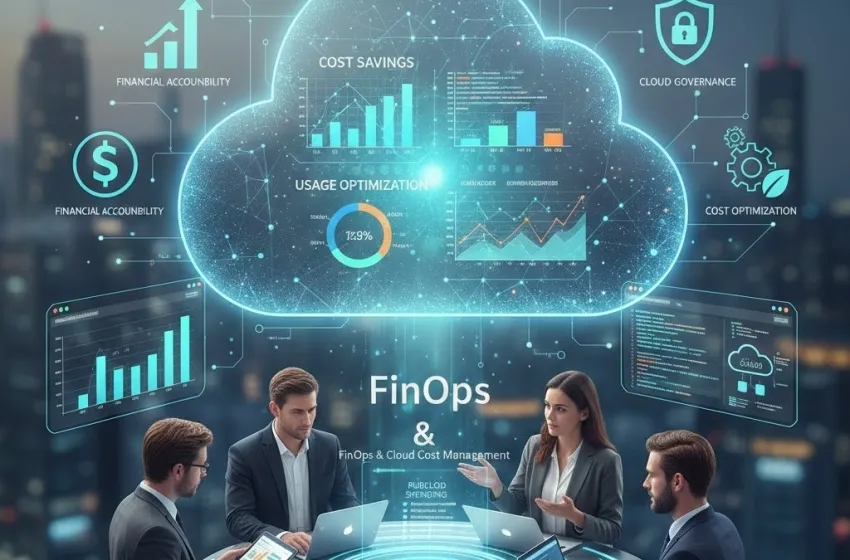Learn how this cultural practice drives financial accountability, cost optimization, and effective cloud governance.
The shift to the public cloud has revolutionized how businesses operate, offering unprecedented agility, scalability, and speed to market. However, this transformative power comes with a fundamental change in the financial model: the transition from predictable, fixed capital expenditure (CapEx) to dynamic, variable spending operating expenditure (OpEx). This shift has introduced a complex challenge for organizations: how to manage and optimize this fluctuating spend to ensure maximum business value. The answer lies in FinOps—an evolving cloud financial management discipline and cultural practice that brings financial accountability to the variable spending model of the public cloud through best practices and tools.
The Imperative for Cloud Cost Management
Before the cloud, IT spending was largely predictable. Companies bought servers, data centers, and software licenses, treating them as capital assets. In the cloud era, resources are consumed on-demand, often with granular, pay-as-you-go pricing. This can lead to rapid, uncontrolled growth in public cloud spending if not actively managed.
Cloud Cost Management (CCM) is the foundational practice of tracking, monitoring, analyzing, and optimizing cloud expenditures. It is the tactical application of methods to prevent over-utilization and waste. Without effective CCM, the business benefits of the cloud—such as agility and innovation—can be quickly overshadowed by skyrocketing costs. CCM primarily focuses on identifying and eliminating unnecessary cloud waste through technical actions like right-sizing resources (matching instance type and size to workload needs), identifying and terminating idle resources (unattached storage volumes, stopped virtual machines), and leveraging commitment-based discounts (Reserved Instances or Savings Plans).
While critical, traditional CCM often remains a siloed effort, typically led by engineering or operations teams, and tends to be reactive, addressing cost issues *after* they occur.
Introducing FinOps: A Cultural and Collaborative Discipline
FinOps (a portmanteau of "Finance" and "DevOps") elevates the conversation beyond simple cost reduction. It is a strategic approach that seeks to maximize business value from every dollar spent in the cloud. It recognizes that cloud spend is not just an IT problem, but a cross-functional business concern requiring collaboration among engineering, finance, and business teams.
The FinOps Foundation defines the practice as the practice of bringing financial accountability to the variable spending model of the public cloud through best practices and tools. This statement is the core distinction from traditional CCM. It embodies three key components:
- Financial Accountability: Every team and individual who consumes cloud resources must be aware of and responsible for the costs they incur. This shifts the culture from "unlimited resources" to one of fiscal responsibility.
- Variable Spending Model: It specifically addresses the dynamic nature of OpEx, where usage equals cost. FinOps practices are designed to harness this variability to drive business velocity—using more cloud resources when they deliver high business value and scaling back when they don't.
- Best Practices and Tools: It is a disciplined approach that operationalizes cost-aware decision-making through established methodologies (the FinOps Framework) and leverages automated tooling for visibility, analysis, and optimization.
[Image of the FinOps Framework with its three phases: Inform, Optimize, and Operate]
Shutterstock
The Three Phases of the FinOps Framework
FinOps is an iterative, cyclical process, ensuring continuous improvement in cloud financial management. This cycle is typically broken down into three phases:
Inform
This phase is focused on visibility and allocation. You can't manage what you can't measure. The primary goal is to ensure that all stakeholders have timely, accurate, and easily accessible data about cloud usage and costs.
- Cost Allocation: This involves tagging cloud resources (using metadata like project name, department, or business unit) to accurately attribute costs to the responsible team or product. This is foundational to establishing financial accountability.
- Showback and Chargeback: Showback provides teams with reports on their usage and costs without directly charging them. Chargeback goes a step further by transferring the cost directly to the relevant budget or cost center, cementing accountability.
- Forecasting and Budgeting: Utilizing historical data and future business plans to predict cloud spend. This helps finance teams set accurate budgets and alerts engineering teams when they are trending toward overspending.
Optimize
This is the heart of cost optimization, where the data gathered in the Inform phase is translated into actionable savings. This phase is primarily driven by engineering and operations teams, but the decisions are guided by business context.
- Usage Optimization: This involves technical actions to reduce waste and improve efficiency:
- Right-Sizing: Ensuring compute instances and storage volumes are appropriately sized for the workload, eliminating excess capacity.
- Eliminating Waste: Identifying and deleting unattached storage, orphaned snapshots, or terminating idle environments (e.g., development or staging environments overnight).
- Automation: Implementing policies and tools to automatically shut down or scale down resources based on defined schedules or utilization thresholds.
- Rate Optimization: This focuses on securing lower prices for the resources being consumed:
- Reserved Instances (RIs) / Savings Plans (SPs): Committing to a specific amount of usage (either compute power or a monetary amount) over a 1- or 3-year term in exchange for significant discounts.
- Spot Instances: Leveraging unused cloud capacity for fault-tolerant workloads at heavily discounted rates.
Operate
The Operate phase ensures that the best practices become a routine, integrated part of the organization’s processes. This is where FinOps becomes a cultural shift—a continuous loop of review, feedback, and improvement.
- Measuring Unit Costs: Moving beyond total spend to understand the cost per business unit (e.g., cost per customer, cost per transaction, or cost per active user). This metric links cloud spend directly to business outcomes, allowing teams to determine if their spending is efficient and driving value.
- Defining and Tracking KPIs: Establishing key performance indicators (KPIs) like Savings Rate, Forecast Variance, and Unit Cost Efficiency to measure the success and maturity of the FinOps practice.
- Process Automation: Automating the execution of optimization recommendations, report generation, and budget alerts to make the FinOps process scalable and sustainable.
The Pillars of Effective Cloud Financial Management
Successful FinOps and cloud cost management initiatives rely on the deliberate cultivation of specific cultural and technical pillars:
Financial Accountability and Ownership
This is the critical cultural shift FinOps enforces. When cloud governance is weak, engineering teams can provision resources without fully understanding the cost implications, leading to public cloud spending sprawl. FinOps ensures that product and engineering teams, who make the technical choices that drive cost, are also held accountable for those costs.
The objective is not punishment for high spend, but empowerment to make trade-offs between speed, quality, and cost. By providing teams with granular, timely cost data, they can own their spending decisions, fostering a shared culture of financial prudence. This is achieved by:
- Clear Cost Visibility: Providing dashboards that are easy for engineers to understand, showing them exactly what they are spending and why.
- Unit Costing: As mentioned, linking spending to key business drivers to assess the return on investment (ROI).
- Decentralized Decision-Making: Shifting spending decisions closer to the teams that consume the resources, trusting them to act as financial stewards.
Cloud Governance and Policy Enforcement
Cloud governance is the set of rules, policies, and procedures that guide resource provisioning and utilization to ensure alignment with security, compliance, and financial objectives. In the context of FinOps, robust governance is essential for preventing cost overruns proactively.
Effective governance includes:
- Mandatory Tagging: Enforcing a consistent and complete tagging strategy across all cloud environments to enable accurate cost allocation. Untagged resources are often referred to as "dark spend" because their financial owner is unknown.
- Automated Guardrails: Setting up automated policies to restrict the provisioning of overly expensive resource types, enforce time-based shutdowns for non-production environments, or limit resource creation to specific, cost-effective regions.
- Anomaly Detection: Implementing tools that use machine learning to detect sudden or unusual spikes in public cloud spending that may indicate waste, a misconfiguration, or a security issue, triggering immediate alerts.
Tools and Automation
While FinOps is a cultural practice, it is operationalized through tools. The sheer volume and velocity of cloud data make manual analysis impossible. Modern cloud financial management platforms provide the necessary capabilities:
- Data Aggregation and Normalization: Combining billing data from multiple public cloud providers (AWS, Azure, GCP) into a unified, normalized view.
- Optimization Recommendation Engines: Using AI/ML to continuously scan environments and generate prioritized recommendations for cost optimization, such as right-sizing instances, identifying idle resources, or suggesting commitment purchases.
- Integration with DevOps Toolchain: Connecting cost data directly into the tools engineers use every day (e.g., Slack, ticketing systems) to make cost-awareness part of the engineering workflow. Automation, driven by these tools, transforms FinOps from a reactive audit into a continuous, low-effort process.
FinOps vs. Cloud Cost Management: The Semantic Difference
The terms are often used interchangeably, but it is vital to understand the difference. Cloud Cost Management is a subset of FinOps.
| Feature | Cloud Cost Management (CCM) | FinOps |
|---|---|---|
| Primary Goal | Solely focused on cost reduction and saving money. | Focused on maximizing business value and ROI from cloud spend. |
| Scope | Technical and operational actions (e.g., right-sizing, deleting idle resources). | Comprehensive financial management (budgeting, forecasting, unit cost, governance, collaboration). |
| Culture | Often siloed, primarily IT/Engineering responsibility. | Cross-functional collaboration involving Engineering, Finance, and Business. Everyone takes ownership. |
| Approach | Often reactive—addressing cost spikes after they occur. | Proactive and preventative—using data to drive real-time, financially-informed decisions. |
FinOps is the strategic framework that embeds CCM activities into a repeatable, collaborative, and measurable business process. It is the shift from "saving money" to "spending wisely."
Conclusion: The Path to FinOps Maturity
The public cloud offers a powerful engine for innovation, but its variable cost model necessitates a disciplined approach to financial oversight. FinOps provides the necessary framework to navigate this complexity, transforming cloud financial management from a technical headache into a strategic business enabler. By fostering collaboration between finance, business, and engineering, enforcing smart cloud governance, and driving continuous cost optimization, organizations can gain control over their public cloud spending.
The ultimate goal of FinOps is not just to cut costs, but to instill financial accountability across the organization, ensuring that every cloud investment is a data-driven decision that maximizes return on business value. Organizations that embrace this cultural and operational shift are best positioned to thrive in the cloud-native future, turning the challenge of variable spending into a competitive advantage.



































